September 21st, 2010 · No Comments
Whenever I see green it makes me so happy. I guess it has a lot to do with the fact that I grew up in really big city, so I didn’t get to see green on a regular basis. In Brooklyn, a park consists of a playground set, and a basketball court. You might get the occasional tennis or handball court, but as far as endless acres of green land…dream on! I would have never expected London to have so much green area being a highly developed, bustling city…but I was so wrong. London is so beautiful, which is another reason why I love it here. There is a balance between man made and nature, and while it is nice to live the city life, it is also necessary to get away sometimes and just take a stroll in the park, and not just Central Park (angry New Yorker), but have a variety of great parks to chose from. Not only are the parks beautiful, they are also so clean and well maintained! You can tell that residents respect the parks here and abide by the rules of sanitation. There are even “dog waste only” rubbish bins scattered around the parks, something that is definitely needed back in the states.
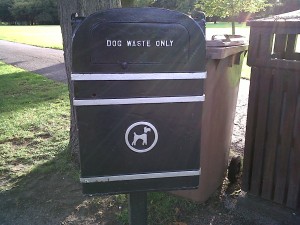
My favorite park would have to be Regents Park. In addition to its endless seas of green, I really loved the Queen’s Rose Garden. I don’t understand why flowers make girls so happy, but they give me a warm fuzzy feeling inside that I can’t explain (LOL). Sarah and I lost all concept of time as we wondered through the garden, mesmerized by roses of all different colors, shapes, and sizes. There was also a pond, and a waterfall, and couples smooching everywhere, which made us gag, but I guess one would say that the garden set the scene for a romantic getaway. Other than the rat that we saw running through the flowerbeds, it was perfect. It was great to see a very diverse crowd enjoying the afternoon in the park. I saw all races, and ages, laying in the grass, playing games, or just strolling along the walkway. I guess enjoying the afternoon in a park, surrounded by green, is something that almost everyone shares in common. If you don’t like parks, then I guess your just weird.
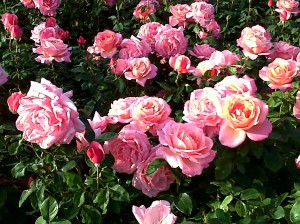
Tags: 2010 Melissa
September 21st, 2010 · No Comments
It took me quite a while to get around to investigating the parks in London. I think most of this is because I had already been to Hyde Park when I was younger (i.e. less interested in such things) and because I was trying to go to so many museums and city-related destinations that I didn’t really think I had the time. Another unconscious reason, I suppose, is that, while I do love Central Park, I just didn’t really think that parks in the middle of a city would be much to write home about. But I was wrong.
While getting caught up in the crowds and the bustle of the city, I completely forgot to, literally, stop and smell the roses- if you’ll forgive the pun. I know everyone I spoke to on the subject had the same experience, but it truly is amazing to walk a few minutes away from the city and find yourself completely surrounded by green. Kaitlin and I decided to get some take away from Harrod’s and bring it to Hyde Park to eat, and we walked straight out of the city and into the rose gardens. (First we had to pass a horse riding trail. It was amazing!) Once you travel farther into the park, it’s even easier to forget that Harrod’s and Knightsbridge are only a few kilometers away.
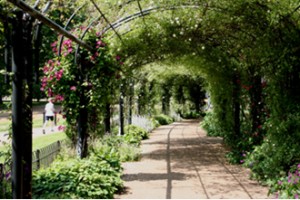
Hyde Park Rose Garden (courtesy of GardenVisit.com)
Hyde Park – photo courtesy of GardenVisit.com
And Regent’s Park, that’s another story entirely. We got off the tube, walked down an upper class residential street, and wound up in what seemed like an entirely different part of the country. With playgrounds, huge green fields, trees, ponds, rose gardens, and high hedges, it is entirely possible to forget that you are in a huge, busy city.
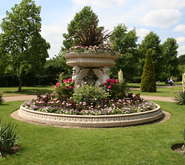
Regent’s Park – photo courtesy of GardenVisit.com
I know it sounds pretty cliché, but it really was fantastic to get back in touch with nature after so seeing much brick and stone day after day. I could have sat and watched the swans swim and stare at the flowers all day. Unfortunately I was only able to spend a few hours in the parks, but it was an amazing diversion from busy city life. And today at Hampstead Heath was completely gorgeous. Some of the girls and I had to take the time to frolic through the fields because we’ve missed nature so much.
Even though I initially dismissed the importance of the parks in London, I loved seeing so much green in the middle of the buildings. And because there aren’t so many skyscrapers in London, it was much easier than expected to forget I was in the city at all. No traffic noise, no pollution, no impatient drivers or pedestrians; just nature, for as far as I could see.
Tags: 2010 Jessica
September 21st, 2010 · No Comments
The parks of London provide a natural respite from the busy, hectic, and stressful atmosphere of the city. Once in them, you are enveloped by a green tranquil, unable to hear the bustle of cars and people outside the parks’ confines. I have personally experienced this phenomenon at several parks, ranging from Regent’s park (where I ran for the first time since surgery! not a bad debut location), Hyde Park, and most others. This type of division between hustle-bustle and repose mirrors the separation of work and play that Fox often talks about.
However, there is also a clear division within the park of activities that mirrors this division of social and work life. There are areas for sitting contemplatively in very silly chairs, which you are supposedly required to pay for. There are areas for looking at quite nice fountains, sculptures, or gardens. Then there are designated areas for sports, with soccer nets and rugby… posts? Tennis courts seem a bit necessary to be fenced off for convenience’s sake. Several little cafés are sprinkled throughout the parks as well.
Regent’s park matches the above description. I’ve made several trips to this park to run, play a bit of ultimate, have a cup of coffee, or just stroll around and look at the great horticulture. However, all of these activities would occur in different locations in the actual park. This segments the activities, and consequently divides the people that enjoy different forms of recreation. Personally, it made me very uneasy. If I were to throw a disc in the wrong area, I risked getting publicly reprimanded (as classmates have experienced). Anyway – it would take quite a bit of time for me to analyze this division (and I really don’t have the experience or expertise to do so) but there has to be some sociological effect. If you have thoughts on this, just comment on this post.
However, not all parks match this model. St. Jame’s park, home of many venereal diseases during the restoration period, per Dennis’ description, is seemingly built for nothing but comfort and relaxing. There are nice little walks along the lake, a couple bridges, some out-of-place fowl, and many large grassy areas upon which you can sit. However, in a couple walks through the park, I never saw anyone playing catch, football, or any other sport in these large areas. Though it was suspiciously absent of proper monuments (at least, I didn’t see many), the website is careful to highlight the pelican feeding from 2:30-3, and the deck-chairs. Weird. More leisure activities. I should note that there is a quite disproportionately small playground for children. However, as a whole, this is not a built-for-fun park. It is a built-for-relaxing-park, and I think is such because of its close proximity to Buckingham Palace. Green Park, also bordering Buckingham Palace, mirrors this model of relaxation, rather than recreational, with a few monuments (such as the Canada memorial), and is a bit more open green spaces rather than pathways-and-lakes. To me, these two parks are just not okay. I envision parks as a place where you can run around, play whatever kind of games you want. Having fancy gardens in parks just seems to counteract this.
Hyde park, the last park I will discuss in this post, blends athletics and relaxation much like Regent’s. And, just like Regent’s, different activities are segmented. There are different areas for sitting in lawn chairs, areas for tennis, I’ve seen people playing soccer on some of the larger fields (quite far away from the chairs, mind you), and the notorious Speaker’s Corner, completely ostracized from any central location. I suspect that its location is completely intentional whatever authority governs the parks wanted to make sure the… colorful characters that frequent the corner would not pollute (in their mind) the rest of the park.
Well, the parks are divided not only from the city but often divided within themselves. What effect this has on the psyche of park attendees, I’m not sure. Though I love the idea of having large parks in cities, I don’t like this division. If you want to have fancy gardens, just don’t call the whole thing a park.

 That these two photos (both personal) came from the same park (Regent’s) makes little sense to me (though the picture from the right, in my opinion, should not even come from a park).
That these two photos (both personal) came from the same park (Regent’s) makes little sense to me (though the picture from the right, in my opinion, should not even come from a park).
Tags: 2010 ChristopherB
September 20th, 2010 · 1 Comment
This afternoon myself and a friend visited Regent’s Park to have a bit of footy in the sunlight. The day was beautiful, and the park was breathtaking. Being my first visit to Regent’s Park, I can honestly say I could have spent days there. The major difference between Regent’s Parl from the other park that I have spent the most time in, St. James Park, was the awesome, gigantic field space used for sporting activites or “ball games”. We spent time in both the large, sport dominated field area as well as the walking route among the gardens and fountains of Regent’s Park (I would have several lovely pictures for you all of our leisurely day, but sadly I left my camera in the hotel upon departure). In comparing Regent’s Park to St. James Park there are a few key differences.

(Regent's Park)
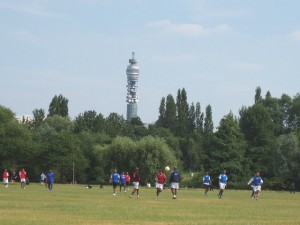
(Sporting Area of Regent's Park)
Regent’s is divided into two sections, the “ball games” field section and the walking route (which has a few little subsections). St. James only has the walking route. Both are beautiful, St. James seemed a little bit more open in the strolling section, and had a little more to offer visually in terms of natural elements (it’s on that fantastic lake and has all those birds running around, it’s hard to beat the pelicans). It seemed like perhaps more manmade work had been done in Regent’s however, the section that we strolled through had several beautiful fountains and well placed gardens, giving it a very tranquil and calm feeling (not as many people either). I could go on for days about how beautiful and elegant these parks were, but I want to discuss what their purpose actually is in British society.
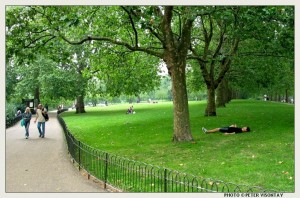
(St. James Park)
The Brits put a lot of pride in three things: museums, churches, and PARKS. These parks all have had one or more notorious architects working on their designs and perfecting them over centuries. They are signature landmarks of the UK, world famous Brits and royalty have worked through them over hundreds of years. Why? Like I said in my blog about the purpose of pubs in British society, it seems like when the Brits aren’t living the hustle and bustle lifestyle of London, in packed tube cars and crowded streets, they like to take a minute to value their time with others and the so called “simple things” rather than spend their time playing watching television or on their computers, like Americans. The Brits are generally doing one of the following things during their visit to the park: walking their dog, chatting with a friend, having a picnic, kicking around the old football, or just having a stroll. All simple, leisurely activities that you don’t need to pay a cover charge for. These parks have so much money and effort poured into them because most of the population of the UK treat them as a national treasure and use them so much. They are a significant part of the history of England. Cheers.
Photos courtesy of: londonrelocationservices.com, yourlocalweb.co.uk, earth-photography.com
Tags: 2010 Benjamin
September 20th, 2010 · 1 Comment
Probably because I get a little claustrophobic in cities, my visits to parks have definitely been some of the highlights of my time in London. I enjoyed the sense of space, the people watching, and the sheer beauty of much of the landscaping. However, I did pick up on a certain artificiality throughout London’s Green space.
First of all, the lakes, which are in most cases absolutely beautiful, provide variety in scenery, are home to so many (sometimes exotic looking) species of birds, and they also provide a fun and novel activity for those who choose to rent paddle boats. In St. James Park, the bridge in the middle of the long, central pond is carefully positioned so that visitors can view Buckingham Palace in one direction and the London Eye in the other. The sheer overcrowding of the birds (and their excrement), especially in St. James Park makes me slightly uncomfortable. It seems as though London attempts to make up for the obvious lack of wildlife in the rest of its urban environment by crowding high quantities into small, carefully designated areas. In the “wetlands” area in Regent’s Park, I noticed a rat basking by the water’s edge along side the usual variety of birds. It goes to show I think, that it is impossible to completely keep out the less picturesque aspects of the city.
The gardens that I visited, and especially those in Regents Park were absolutely beautiful. Signs pointed out over twenty different species of roses, and everyone who I saw seemed to walk through slowly. However, when I reflected on how often the grass must be cut, to keep it that short and the precise patterns in which the plants were arranged, the set up seemed more like a human achievement than natural beauty. Hours of work daily clearly go in to maintaining the gardens.
Playgrounds in London’s parks also seemed equally controlled . Every playground that I have seen so far is fenced in, and most do not allow people in unless they have children with them. These playgrounds, which are often large and colorful, must be a welcome refuge to parents who live in the city and are accustomed to having to constantly watch their children in all public places. They definitely reinforce my impression that London makes it a priority to provide leisure space, but only carefully controlled leisure space.
That said, anyone is free to walk into the vast majority of London’s parks. People from all walks of life go there, though it is not a place to interact with strangers. It is socially acceptable to be alone, with large groups of friends or family, or anything in between. In many there is enough space to talk loudly, but I was able to find somewhere quiet in Regents Park to sit and read a book. Maybe all of the control allows for a greater sense of freedom.
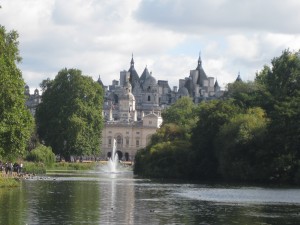
St. James Park (Personal Photo)

Hyde Park (personal photo)
Tags: 2010 Emily · Uncategorized
September 20th, 2010 · 2 Comments
I have been avoiding the parks post because I initially felt like I had very few interesting things to say about them. I’ve spent a ton of time in Hyde Park (because I keep coming back to see if there will be people at Speakers’ Corner), some time in Regents Park and briefly visited the other ones plus the various greens and squares in the middle of the city. A lot of people have already mentioned that the parks are very beautiful, good places to withdraw from city life, make beauty accessible to people of all classes and economic means, etc. All good points, so I won’t beat them to death with another post about them.
I wandered about Hyde Park to a good two hours one day because I got lost, it’s huge, and the landscaping does a really good job of hiding the existence of a city outside the oasis inside (It’s kind of like how the mega Walmart at Dickinson has no windows so once you get in you lose your ties to the outside world and can’t escape, except Hyde Park is absoloutely beautiful and a not soul sucking). Anyway, what struck me as really weird was that a lot of the park seemed to have no other function than to be pretty. Every park I’ve ever been to at home is composed of a playground to entertain kids and open space to play sports. They might be landscaped or otherwise decorated, but that part takes up very little space. Landscaping at home serves as decoration for a space designed for some other purpose, while her prettiness seems to be the main purpose and other functions (open fields, playgrounds, etc.) are an afterthought in a different section. (I’ve also spent very little time in big city park, so it might just be a difference in suburban and urban parks). For example, the first section in Regents Park does not allow balls, so I had to go to a different, less decorative part to play Frisbee. It’s very deliberately divided up.
Assuming it’s not just an urban suburban difference, I think designing a green space just to be a green space and having these deliberate divisions is very in keeping with the English character, the London character in particular. Kate Fox talks a lot about the obsession with privacy. People like to have their own sectioned off garden with a very high fence. They hold up giant newspapers in the subway, stare straight ahead, or make out in very public places as a way to section themselves off into artificial private spheres. The character, Wemmick, from Great Expectations divides his home and work spheres so completely that he seems like he has multiple personality disorder. It’s as if it’s an English disease (thought I think not necessarily always a bad thing).
London is a crowded place, and I can totally understand the need to have all these spheres to create a semblance of privacy. In the Arran House alone, I’ve been having private skype conversations that my entire hallway can hear while sitting in view of one of the cameras at the desk; I’ve just been pretending it’s a private sphere. Parks in London just seems like a strong physical manifestation of these psychological divisions – a section specifically for just being pretty, a section for runners, a section for team sports, a section for free speech (Speaker’s Corner). It’s the very opposite of the complaints I so often here in the United States about our over-stimulated, forever multitasking populace. It actually makes me wonder if British television, advertisement, and video games are significantly different from American ones. As far as I know British students start specializing much earlier, too. In contrast, our education system stresses the idea of the well-rounded student, good at every subject in school and doing a million extracurriculars to get into (among other types of schools) a prestigious liberal art college that continues to focus on well roundedness (required courses in other disciplines), even though the job market is specialized. That’s getting a little off topic, though.
Bottom line: parks — super pretty. Divided into single purpose sections. Reiterate the idea of British spheres for the purpose of privacy (although I think there are many other purposes and results of those spheres besides privacy).
Pictures coming as soon as my computer stops being lame.
Tags: 2010 Jesse
September 20th, 2010 · 2 Comments

One of the things that make London distinct from almost any other city I have visited is the amount or room dedicated to parks. Walk a few blocks and you are bound to encounter a vast expanse of greenery, or see a small garden area with some benches and statues. While a few of these parks (particularly Greenwich) are more organic in nature, and feel just like large open space areas to roam, most of these parks feel planned out to the last blade of grass. Hyde Park boasts a picturesque lake(The Serpentine) with neatly laid out park benches around it. The grass in St. James’ Park is always perfectly cut, and the main bridge in the middle of the park looks like it was installed yesterday. The shrubbery and gardens in Regent’s Park remind one of Versailles. All of these places seem sculpted to be as visually pleasing as possible.

The trend seems to be that the more central the park to the center of the city (Particularly St. James’ and Regent’s Parks), the more likely the park is to be perfectly planned and sculpted. There are several possible reasons for this. One, it could simply be that the city anticipates more people going through these areas, so they want them to look the nicest. Another possibility is that they expect these areas to get the most tourists, and the parks exist more for image than actual recreation (a point I’ll get to a little later). Finally, it could be that these areas are closest to the monarchy, and they have more of a say over these parks. Whatever the reason, there is no doubt that the parks in London are far more mapped out and planned than a majority of parks in American cities.
The question now is: is such planning a good thing? I personally see it as more of a mixed bag. The parks here are much more visually stunning than most I have seen elsewhere. The feel of the parks harkens back to the original intention of the parks: to make the poor and unprivileged feel like they had access to the wealth of the monarchy. You really feel like you are walking through the Queen’s personal gardens when you take a stroll through Regent’s Park. However, this meticulous planning takes away a little bit of personality from the parks. I get no sense of true, organic, nature while walking through St. James because everything feels so mapped out. In addition, the regal nature of the parks appears to hinder a lot of activity within the parks. Most people seem to simply be walking slowly through these areas, or sitting on a park bench. There are rarely any cyclists, joggers, Frisbee players, kids running around, or anyone playing games. This inactivity is partially because a lot of games are banned in certain areas of the parks, but I think it is also due to the intimidating nature of such perfectly sculpted areas. After walking through the immaculately-trimmed hedges of Regent’s, or after crossing the bridge in St. James’ with the marvelous view of Buckingham Palace, it is hard to think: “Gee, this is the perfect place to run around and throw a Frisbee.” As a result of such overplanning, the parks lose this energy, and also a little bit of quirk.

I love the fact that London has so much green space, and that the city takes such good care of these areas. However, the parks are so meticulously sculpted that the areas seem almost unnatural. The lack of physical activity makes the area feel calm, but it also takes something away from its overall personality. I have enjoyed my time walking through London’s parks, but one wonders whether a bit less planning would make these areas more fun and inviting to the public.
Tags: 2010 Andrew
September 19th, 2010 · No Comments
The parks in London, as people have already noted, are places of beauty and enjoyment. Yet, they are not all created equal, well, no, used equally. When relaxing in various ones, I noticed that some were more touristy. In fact, within some, one area was more likely to be touristy that an other.
My first introduction to a London park was when we had class in Russell Square. Clearly, people weren’t used to seeing a group of students (much less Americans) in August discussing various ideas about immigration. Yet, I can’t imagine being at UCL and not using the space for at least small study groups, if not classroom discussions when the weather turns nice.
I adore the idea of small squares littered throughout the city ready for use whenever someone wants an escape from the business and chaos of the city. Of those I noticed, the squares I most wanted to go into were locked and only accessible by the area’s residents. I have mixed feelings on this. On one hand, it’s great for residents to have a safe place to go with their young children or a quiet place where they don’t have to worry about tourists wandering through talking loudly (oops). On the other, why shouldn’t these spaces be opened up for everyone? It feels like one more thing that add to English hypocrisy: they want to pretend when it’s convenient that class doesn’t count, but it seems to exist in these situations when the restricted squares seem to be in areas where income looks to be higher.
For the actual parks, my favorite has been Kensington Gardens. I loved the duality of the park: one side was quiet and peaceful and the other was busy, well, as busy as a park can be. Residents played with their dogs as tourists wandered through taking photos and trying to find the actual park, Hyde Park. Hyde Park was also rather enjoyable, but was far busier on the day I visited. Granted, searching for the Peter Pan statue also lends the visit to being centered around the busier areas. I enjoyed walking through Kensington and observing people and how they interacted with the space (mostly walking their dogs or playing fetch with them, as well as a few taking their young children out for a walk). In Hyde I felt like I was only there to check it off of my list of “Things To Do in London.”
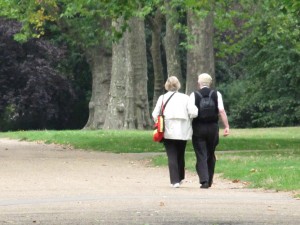
Regent’s Park, while a lot like Hyde in some regard also demonstrated this dualistic atmosphere. The park seemed to have a few tourists wandering through (especially as you got closer to the Zoo and in the more French style areas), but it also had a lot of Londoners, some out walking and others with their family (or dogs). I much preferred the areas that were mostly charming (and alarmingly uneven) paths, where others were walking with their dogs. The other thing that I liked about Regent’s was how family friendly it was. There was a playground that was obviously popular among families with young children.
I’ve enjoyed the parks that I’ve visited and they’ve helped convince me that London is actually my favorite city in the world because of their place in the life of the average Londoner (or student visiting for the month): they’re key to staying sane here. I thrive on the chaos of the city, but sometimes nothing is better than a quiet stroll through a park or an hour reading in a square. I hope that as I venture to other places in England that I will be able to go to a few other cities’ gardens/squares/parks and see how they differ.
Tags: 2010 Stephenie
September 15th, 2009 · No Comments
-
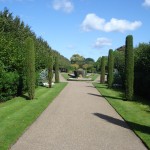
-
Regents Park
-
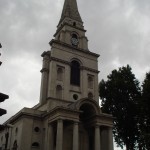
-
Christ’s Church
-
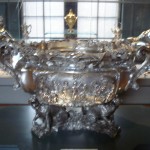
-
The Silver Exhibit in the V&A
-

-
Having a Good Time at the Fitzroy
Like many of my classmates I decided it would be worthwhile to summarize all of my discoveries this month in London. During this post I will focus on six main themes found within London: Parks, Churches, Pubs, Other Religious Institutions, Theatre and Museums.
Parks
Each park that I visited had its own distinct characteristics that separated it from any other. Green Park was the first I visited and after perusing a few others, I realized there was nothing that exciting about it. Located right across from Buckingham Palace, Green Park certainly provides a good place to go and take a break from the busy atmosphere of the area. Besides this however there is not much going on and I would recommend that potential park goers walk the extra distance over to St. James Park.
In addition to the large number of waterfowl heckling people for food which offers consistent entertainment St. James offers some picturesque flower beds throughout and various monuments along the way. It has the relaxing atmosphere of Green Park with a bit more excitement sprinkled in.
Regents Park offers a completely different feel from Green or St. James. Located in a separate area of London, Regents Park has a history of being used by a higher end crowd. I could tell this immediately from the feel of the park. The decorative shrubbery and elegant architecture throughout gave me a feeling that Regents is not as well used as other parks.
Since I was one of the members of the Parks group that gave a walking tour of Hyde Park and Kensington Gardens I could go into a lot more detail about these two green spaces but I will choose not to in an effort to be concise. In summary Hyde Park is the largest green space in London and is often used for larger events such as concerts, festivals etc. It also contains a large number of monuments throughout including the 7/7 memorial and the Diana Memorial Fountain. Kensington Gardens is home to a variety of key monuments but is not as well trodden as Hyde. Overall it makes for a quieter atmosphere, more conducive fo reading or “snogging”.
Regents Park were my two favorite green spaces in London. Regents, is both beautiful, and extremely large and I continually felt the need to go back and explore. Kensington Gardens appealed to me in that it was quainter than Hyde Park but contained a like amount of history and monuments throughout. Although I would be content spending a length of time in any London green space Regents and Kensington would be my top choices.
Theatre
Overall I enjoyed going to the theatre on so many occasions. What better place to do so than in London after all? Here I will discuss my favorite performances and theatre venues.
All in all I enjoyed all but two of the performances we saw. The two Shakespeare productions at The Globe Theatre were fantastic. Although I did not particularly enjoy reading Troilus and Cressida it made a huge difference to be there so close to the actors. The fantastic drum chorus at the end really sealed the deal. As You Like It was probably my favorite show I saw here in London. Although it is one of Shakespeare’s simpler plays the actors really made it jump off the page. Being down it the pit was fantastic because of all the ad-libbing and constant interaction with the crowd. I even felt traces of Touchstone’s saliva on my arm at one point.
The other Shakespeare performance I saw, All’s Well That Ends Well, was lackluster. Although the Olivier was my favorite performing venue (this is what an auditorium style theatre should be like…why can’t Dickinson have something like this?) the play itself was odd and ended on an abrupt and odd note.
The other play we saw at the National Theatre, The Pitmen Painters, was fantastic. Although I was dozing a bit because of the Benadryl I took right before the show, the actors kept my attention and I appreciated that the play was based off of a true story.
Easily the oddest play we saw was Arcadia. An extremely intelligent performance the play juxtaposed two different periods in time and created a singular storyline in which the plot was based. Overall it was an entertaining performance that made me think early and often.
Finally there was Blood Brothers. The lone musical I saw produced feelings of disbelief, anguish and held back laughter. The ridiculous 80’s sound track and creepy narrator just didn’t do it for me. I think it’s safe to say that I was not the only one from Humanities 309 who was a bit surprised to see just about everyone in the audience give it a standing ovation.
I had a very positive experience with the theatre here. I would go back to the globe again and again. I loved being that close to the action. I would also enjoy seeing another show in the Olivier. There really is so much to choose from here. It’s simply a matter of figuring out your tastes and saving your money so you can see a lot of performances.
Churches
From Westminster Abbey to St. Paul’s Cathedral we saw most of the major churches/cathedrals during our month in London. St. Paul’s was easily my favorite. From the fantastic crypt to the hundreds of stairs up to the tower it had so much to offer in the way of history and mystique. Westminster Abbey fascinated me primarily because of all the literary figures that had been buried inside as well as the room that was dedicated to “The Order of the Bath”. Other churches that I really enjoyed taking a look at were: “St. Martin in the Fields” which sits just outside Trafalgar Square and Nicholas Hawkesmoore’s “Christ’s Church” which is located in very close proximity to Brick Lane.
Other Religious Institutions
Overall the Sikh Gurdwara was my favorite place that we visited. I appreciated the simplicity of the religious doctrine as well as the conviction and honesty with which our tour guide, Mr. Singh spoke. The morning was capped off with a fantastic sit down meal together in which everyone was served the same food and drink.
I had different feelings about the Hindu Mandir. It was clear to me from the very beginning that the Hindu religion is not nearly as modest as Sikhism nor are they trying to be. From the extremely decorative prayer room, to the museum located right in the center of the Mandir I never felt particularly comfortable inside.
The only religious institution I wish we had gotten a chance to visit is a Mosque. I had been to one many years ago but I did not remember a whole lot from my experience. I wonder how much more lively the East End, and all parts of London would be if Ramadan were not taking place during our time here.
Museums
I could go on and on about museums so I will attempt to stay as concise as possible.
The British Museum was massive, convenient since it was so close to the Arran House but a little one dimensional at times. One of my favorite exhibits at the British Museum was a special exhibit on Living and Dying that drew information from all different time periods and cultures.
The National Gallery was fantastic. Although I have a hard time appreciating some visual art the gallery kept my attention for a number of hours. Seeing so many famous works of art was phenomenal.
The Tate Modern was my least favorite museum here. Although I am trying I have a hard time understanding modern art. After about 45 minutes in this museum it ended up being too much for me.
The Cabinet War Rooms/Churchill Museum were two of my favorites. The realization that I was standing in one of the most important places in World War II history was unbelievable. The War Rooms felt so authentic. I really felt as though I had been taken back in time to the 1940’s while inside.
The Victoria and Albert was easily my favorite museum in London. There was so much variety inside and so much to see. I could have easily spent a few days inside. Two of my favorite exhibits were the silver and jewelry exhibits. I’m not sure what this says about me as a person but I found it unbelievable that individuals could even own such treasures. I also enjoyed the laid back atmosphere of the V&A staff. At most of the other museums I visited I felt like I was doing them a disservice simply by being there. Although I understand that taking pictures of an object in a museum doesn’t do it justice I like to be able to have the option of doing so.
The Sir John Soane museum interested me but it wasn’t really my cup of tea in the end. It also had a stuffy atmosphere to it that I didn’t really appreciate.
One thing I can draw from my experience at museums here is that each and every one has something that distinguishes it. With so many museums I thought that it would be impossible to avoid some overlap but I never really felt that. Cheers to London and its museums.
Pubs
Finally we have pubs. What would London be without it’s public houses? In some cases pubs are the true museums of London, designating what an area was like in the past and what type of clientele it attracted. During my month here I had a chance to visit a few pubs and get a general sense of what some possible differences could be. It is clear to me that each pub brings something different and unique to the table. The Marlborough Arms was convenient being so close to the Arran House and was a great place to enjoy a pint over a meal with friends. The Court was conducive to socializing in a different way. The music was louder, the people louder and the drinks cheaper. Other places I visited offered other things that made them stand out as well. One thing that i’ve learned about pubs is that it’s hard for one to please everyone. Since everyone has different tastes and desires when it comes to pubs you are better off going to one with a small cohesive group.
To conclude this novel I would just like to say that I think we saw a lot of different faces of London this month. I realize there is much more to see here but between walking tours throughout the city, trips to major monuments and museums and individual exploration I have learned a ton about London, it’s history and where it is going. I look forward to more London explorations in the future but for now, ON TO NORWICH!
Tags: Churches and Cathedrals · Henry · Pubs · Theatre
September 14th, 2009 · 2 Comments
I had the chance to attend the Feminist Literature tour in which I not only learned about women writers who resided in the Bloomsbury area, but also on how spaces affect who we are and everything that we do. I am intrigued with this notion. Recently I posted a blog on space, specifically focused on sacred/holy spaces, in this blog I will look back and focus on a few others others.
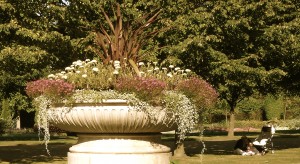
Green Green GREEN
Spaces of recreation, golden flowers and perfectly trimmed grass is what I think of. It is impressive to me how well kept they are. When we visited Regent’s Park during class for the first time, I was at a loss of words, for I had never in my life seen a space so beautiful. William Blake captures this beauty in his poem titled “The Lily:”
The modest Rose puts forth a thorn,
The humble sheep a threat’ning horn:
While the Lily white shall in love delight,
Nor a thorn nor a threat stain her beauty bright.
Regent’s Park could not be touched, human hands could never be gently enough to handle a flower’s delicate body. So untouchable, the flowers arranged almost to perfection. Ralph Waldo Emmerson once said that “Earth laughs in flowers,” and I believe him.
Hyde Park, almost as magical, but words cannot capture the immensity of this park. The amount of green that surrounds you at any given moment is difficult to describe. This park in particular serves as more than just a space for recreation, it is also a place where history is preserved, where various neighborhoods unite and where kids grow up to later bring their own kids to play at Kensington Gardens or near the lake. Green Park, a sort of gateway to Buckingham Palace (if you get off at the Green Park Tube station), can never be compared to Hyde Park for it lacks in immensity. Even though the deck chairs are a nice touch to the park, the area I visited lacked some color (as in floral color); I was not impressed. (Buckingham Palace itself was not very impressive. I was surprise to discover that it actually isn’t an enormous, glorious and royal-looking mansion… I guess it’s a good thing that it isn’t after all!)
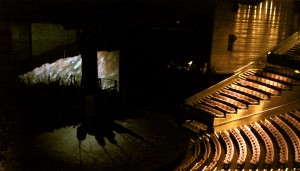
Let’s start the show!!!
Sometimes walking in for the first time takes my breath away, and sometimes the shows blows my mind, other times the idea of sitting there makes me wonder… wow. The three different halls of at the National Theatre, The Globe, Duke of York’s, the Phoenix and last but not least Royal Albert Hall! So here’s the list: “Troilus and Cressida,” “Arcadia,” “All’s Well That Ends Well,” “As You Like It,” “Pitmen Painters” and the not-so awesome musical “Blood Brothers,” oh and the amazing violin concerto at the Royal Albert. In London, I am never too far from New York City’s Broadway experience! The difference, the London experience always feels fulfilling no matter how horrible the play was. This is probably because Broadway shows are not exactly affordable, and while the National Theatre insists on having a wide range of prices (so that everyone can enjoy the theatre), Broadway just seeks revenue and to maintain it’s current status and popularity. I mean, to have Rick Fisher (who by the way is a Dickinson alum), winner of of a Tonny award, come to speak to us about his thoughts and experiences with London’s theatre scene, that within itself was enough to top all of the Broadway shows I have seen in my life! I <3 the London theatre experience!
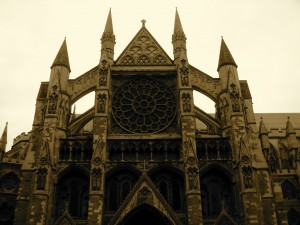
Religious spaces.
Intricate architecture, imagination, creativity and grace is what comes to mind when I think of churches. I’ve written a blog about them but I wanted to look back at a few of them. Westminster, ridiculously sacred, marvelous, immense and glorious. The same can be said about St. Paul’s Cathedral and the Hindu Temple we visited. At Brixton (where I directed a tour along with my teammates), I learned that religious spaces play a huge role in the community, one that extends beyond any religious affiliations. One specific church we visited during our research, Corpus Christi Roman Catholic church was involved in the reconstruction of the Brixton area after the Brixton riots, when parts of the neighborhood where damaged/destroyed due to violent protests. It always brings joy to my heart when people come together to help each other, regardless of any religious/cultural boundaries.
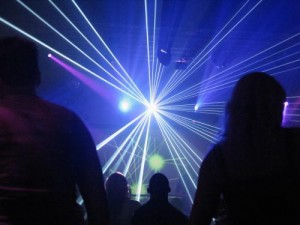
Clubs NOT Pubs
Ooooh pubs…. I’ve heard that you can see London’s history evolve in these spaces, and although they are known as spaces of leisure and social interaction their walls can tell unknown stories of both know and unknown visitors. I am always intrigued by pubs, so intrigued I am intimidated by them. I now that sounds a little ridiculous but in pubs I feel pressured to consume alcohol (after all that is the main purpose of a pub: to provide alcoholic beverages) and to maintain conversation when really all I want to do is dance to the awesome music playing in the background. Rebbeca (who along with 4 others constructed a tour of London’s historic pubs) has attempted to both enlighten me as well as persuade me to engage in pub culture, but I have yet to fully explore the wonderful world of London’s historic pubs.
Clubs, on the other hand, I’ve also had a difficult time with. I’ve realized that there isn’t much dancing that goes on, but rather an attempt to dance, which actually means jumping around to Lady Gaga’s “Just Dance” (pop/techno song). Over all, I have enjoyed late hip hop nights at Metra (dance club a few street corners off the Leichester Square tube stop) only because I have shared that space with amazing people who can turn any floor into a dance floor. (Thanks Anthony, Jeyla and Patsy!)
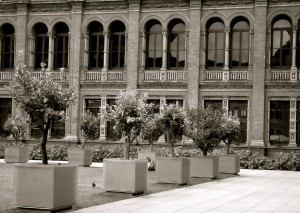
Spaces, our everyday living takes place within them, whether they are churches, clubs, parks or theaters. We lack to realize their importance, we never stop to think of how a room may affect how we feel about ourselves and about the rest of society. A room can change our lives, like the reading room at the British Museum that the feminist writers group spoke of on their tour. This room clearly changed Virginia’s Wolf literature, among other authors, I’m sure.
Note to self: Whether this room is physical or mental, it is important. We must take more time to appreciate a rooms ability to change the way we exist in our own individual worlds.
The End.
Tags: Flow · Uncategorized
























